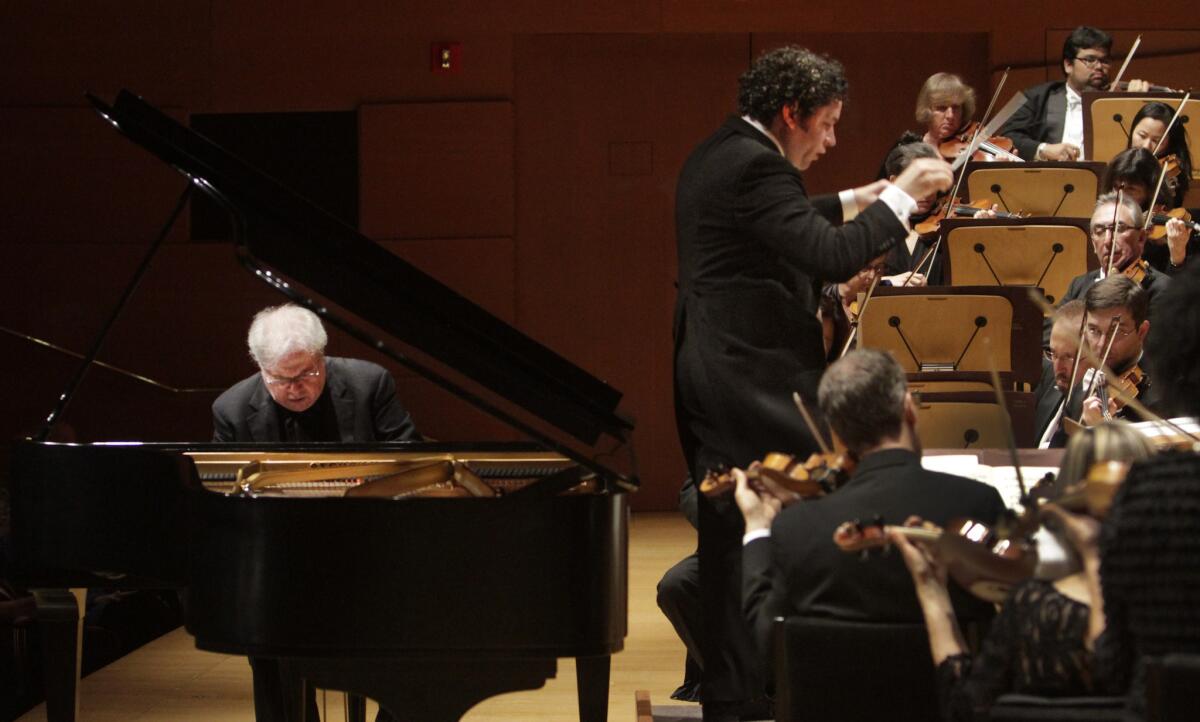Emanuel Ax’s Brahms Project concludes climactically

- Share via
A large audience turned up at Walt Disney Concert Hall Thursday night to hear Emanuel Ax perform Brahms’ big Piano Concerto No. 2 with the Los Angeles Philharmonic. That is hardly surprising. Ax is a popular, amiable pianist. Brahms is a popular, amenable Romantic. And Gustavo Dudamel is back.
And so is the Brahms bomber, however avuncular Ax might appear.
The Second Concerto winds up the pianist’s Brahms Project, which began with the First Concerto in January conducted by Robin Ticciati and included two recitals at Disney, one with mezzo-soprano Anne Sofie von Otter featuring Brahms songs and another with Yo-Yo Ma for the cello sonatas. What, you might wonder, could be more conventional than that?
Not much, were Ax to take Brahms’ outward stodgy conservative Romanticism at face value. But Brahms’ complicated cozy melodies, dense harmonies, tricky rhythms and glutinous textures concealed a closeted progressive. His music can be a heavy soup, and that appeals to some young composers today who treat musical ingredients like modern cuisine, a mixture of tastes meant to add up to a rich experience.
Ax’s Project has been to see what, if anything, Brahms might mean to today’s composers. To that end, he has thus far commissioned small piano solos or songs from fashionable young New Yorkers Nico Muhly and Missy Mazzoli and the Australian Brett Dean.
But Ax saved the most ambitious and most audacious for last, the L.A. Phil commission of Andrew Norman’s “Release.” This 20-minute fantasy for piano and orchestra, which had its premiere Thursday, is a dialogue with Brahms by a young West Coast composer who has given up a brief Brooklyn idyll to join the faculty of USC, his alma mater.
Ax had asked Norman to think about using notes that had special meaning for Brahms — the motives F-A-E and F-A-F. These stood for “Frei aber einsam” (free but lonely) and “Frei aber froh” (free but happy). For Norman, this became a meditation on freedom and solitude. Although a far cry from his video-game hot-rodding student music of a decade ago that got him his first attention, “Release” is, in its quietly subversive way, a perfect booby trap for the Brahms bomber to employ.
“Release” began with the pianist silently and slowly depressing individual keys while holding down the sustaining pedal, thus creating an atmosphere of heightened resonance but with no real sound other than an occasional plunk. The strings in the orchestra entered individually, with sustained tones in harmonics. The effect was that of Ax willing the orchestra into action as if through telepathy.
It was a spooky and a tense beginning and generated perhaps nervous coughing fits from an unsuspecting audience. The orchestral participation gradually grew into a harmonic abundance, and Ax swirled around these instrumental clouds with gorgeous glittery figurations. Climaxes rose and fell like the deep breaths of Zen monks meditating in a tranquil rock garden.
Norman offers the orchestra instants of freedom. He peppers his score with boxes of notes that can be unpacked at will. The result is curiously Brahmsian in the way intricate and rhythmically uncoordinated details produce a lavish big picture.
“Release” is a wonderfully fresh way to think not only about Brahms but also about where music might be now going. In a pre-concert talk, Norman mentioned Terry Riley’s modular “In C” as one influence, which nicely connects his commission to the Minimalist Jukebox the L.A Phil recently concluded.
But Norman also pays mind to the experimental American tradition and, in particular, to the subtle, elegant, inwardly elegiac character of the music of Morton Feldman. Two years ago in San Francisco, Ax brought a unique inner beauty to Feldman’s Piano and Orchestra. He captured the same enchanted spirit and quality in “Release.”
“Release” was surrounded Thursday by late Brahms. Dudamel began the program with a delightfully nuanced and irradiated performance of “Academic Festival Overture,” written in 1880. He concluded, after intermission, with the piano concerto, composed a year later.
Here, Ax was not so much a Brahms bomber. The concerto is one of his specialties. What seems to keep him interested in it is what the orchestra brings to the performance and how he can react to the players. Dudamel’s approach was broadly symphonic, to which the pianist eagerly joined in.
But it was in the more personal, rapt chamber music moments, that Ax really shined, whether reacting to Andrew Bain’s radiant French horn opening solo or understated elegance of Robert deMaine’s cello solos in the slow movement.
For his encore, the Brahms bomber lobbed something unexpected. He asked deMaine to join him in the third movement of Chopin’s cello sonata.
--------------
Emanuel Ax Brahms Project with the Los Angeles Philharmonic
Where: Walt Disney Concert Hall
When: 8 p.m. Friday and Saturday
Tickets: $20-$200
Contact: (323) 850-2000 or https://www.laphil.org
More to Read
The biggest entertainment stories
Get our big stories about Hollywood, film, television, music, arts, culture and more right in your inbox as soon as they publish.
You may occasionally receive promotional content from the Los Angeles Times.











